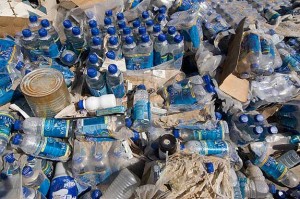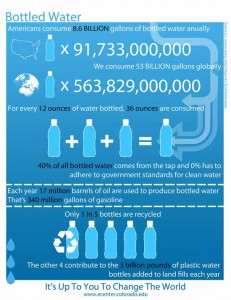Bottled Water: An Economic Perspective
Mar 14th, 2014 | By admin | Category: Water IssuesBy Anjie Cai, guest youth blogger for www.howmany.org.
It’s frightening to look at bottled water from an economic perspective. Using cost-benefit analysis to examine the impact of bottled water, we realize how harmful it actually is. The Environmental Working Group’s 2011 Bottled Water Scorecard reported that bottled water costs “up to 1,900 times more than tap water,” and more than 90% of that goes towards packaging, bottling, shipping, marketing, and other expenses. This does not account for the hidden environmental and health costs.Eighty million bottles of disposable bottled water are consumed every single day in America. Of those, 30 million show up in landfills. The National Post-Consumer Plastics Bottle Recycling Report recorded the highest percentage – 30.5% – for plastic bottle recycling in 2012. This leaves a large unaccounted number of plastic bottles that end up as pollution.
Much plastic pollution ends up in the ocean. I have gone to beaches and seen them littered with improperly disposed bottles or plastics brought in by the tides. Many people do not know about the trash vortex, aka the Great Pacific Garbage Patch, which is chock full of plastic debris. It is about twice the size of Texas, floating in the middle of the Pacific Ocean. Plastic bottles and everything else left on streets goes down drains and eventually end up in a local body of water or an ocean. Nearly 90% of marine litter floating in the ocean is plastic. Some of the improperly disposed bottles end up in the trash vortex and endanger fragile marine ecosystems.
In addition, production and transportation of bottled water uses an inordinate amount of resources. The plastic bottles are made from oil; Tapped the Movie, a documentary on bottled water, reported that it takes 714 million gallons of oil per year to make plastic water bottles for U.S. consumers. Elizabeth Royte, author of Bottlemania, found that water in bottles only accounts for 60% to 70%, on average, of the water that goes into the production of bottles. The rest of the water is used to cool the manufacturing machines. Energy goes into the factories that produce bottled water and the transportation that follows the production.
Each year, big businesses like Coca-Cola, Pepsi, and Nestle pump millions of dollars into advertising their respective bottled waters. They advertise with misleading messages like healthier and cleaner water, add prepared minerals to flavor their water, and associate their brands with models or celebrities.
The truth is that most of the time bottled water is of the same quality as tap water, since both come from the same municipality sources. The Safe Drinking Water Act has numerous regulations that have more frequent and stringent tests for tap water than the FDA standards for bottled water. Some studies have found mold, kerosene, algae, yeast, sand, and even crickets in bottled water. In those cases, tap water is safer to drink, undergoing more contaminant, bacteria, and chemical tests, and with water quality reports accessible to anyone online.
I wonder if people will continue to drink bottled water after understanding the cost and benefits of bottled water. I know I won’t.
Anjie Cai is a student at Irvington High School in Fremont, CA and is interested in studying political science and economics.
(Reference: Bottled Water: The Risks to Our Health, Our Environment, and Our Wallets)


